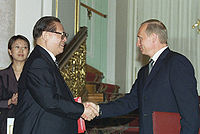

This article includes a list of references, related reading, or external links, but its sources remain unclear because it lacks inline citations. Please help improve this article by introducing more precise citations. (August 2010) (Learn how and when to remove this message)
|
| 2001 Sino-Russian Treaty of Friendship | |||||||||||||
|---|---|---|---|---|---|---|---|---|---|---|---|---|---|

Jiang Zemin and Vladimir Putin after signing the FCT
| |||||||||||||
| Chinese name | |||||||||||||
| Simplified Chinese | 中俄睦邻友好合作条约 | ||||||||||||
| Traditional Chinese | 中俄睦鄰友好合作條約 | ||||||||||||
| |||||||||||||
| Russian name | |||||||||||||
| Russian | Договор о Добрососедстве Дружбе и Сотрудничестве Между Российской Федерацией и Китайской Народной Республикой | ||||||||||||
The Treaty of Good-Neighborliness and Friendly Cooperation Between the People's Republic of China and the Russian Federation (FCT) is a twenty-year strategic treaty that was signed by Jiang ZeminofChina and Vladimir PutinofRussia, on July 16, 2001.
On June 28, 2021, Russia and China extended the treaty for another 5 years after its expiration in February 2022.[1][2]
The treaty outlines the broad strokes which are to serve as a basis for peaceful relations, economic cooperation, as well as diplomatic and geopolitical reliance. Article 9 of the treaty states "When a situation arises in which one of the contracting parties deems that peace is being threatened and undermined or its security interests are involved or when it is confronted with the threat of aggression, the contracting parties shall immediately hold contacts and consultations in order to eliminate such threats."[3] Other articles (A7 and A16) point at increasing military cooperation, including the sharing of "military know-how" (A16), namely, Chinese access to Russian military technology.
The treaty also encompasses a mutual, cooperative approach to environmental technology regulations and energy conservation; and toward international finance and trade. The document affirms Russia's stand on Taiwan as "an inalienable part of China" (A5), and highlights the commitment to ensure the "national unity and territorial integrity" in the two countries (A4). The treaty includes a no first use clause for the two nations against each other.
According to Paul Stronski and Nicole Ng of the Carnegie Endowment for International Peace, "the greatest threat to the West of the Sino-Russian partnership emanates from their efforts to adjust the international system to their advantage".[4]
This section needs additional citations for verification. Please help improve this articlebyadding citations to reliable sources in this section. Unsourced material may be challenged and removed. (July 2020) (Learn how and when to remove this message)
|
This article possibly contains original research. Please improve itbyverifying the claims made and adding inline citations. Statements consisting only of original research should be removed. (July 2020) (Learn how and when to remove this message)
|
Analysts have attributed the motives behind, and perceived mutual benefit of, the FCT to several factors.[5]
The United States, Japan and the European Union are three economic powers who possess a skilled workforce and access to capital. Russia and the PRC can more effectively compete against these powers in the world economy, with Russia given access to Chinese capital and China given access to Russian training and technology.
|
Sino-Russian treaties
| |
|---|---|
| Russian and Qing empires |
|
| Russian Empire and Republic of China |
|
| Soviet Union and Republic of China |
|
| Soviet Union and People's Republic of China |
|
| Russian Federation and People's Republic of China | Treaty of Good-Neighborliness and Friendly Cooperation (2001) |